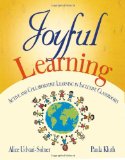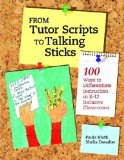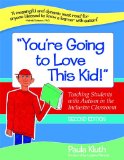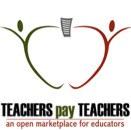Place value picture books
Picture books are such a novel way of introducing a new concept or skill in mathematics and, because they are not used nearly often enough, introducing a few into a lesson can make it all the more memorable. Your school librarian will undoubtedly be able to suggest titles for any unit, but to get you started, here are some ideas for teaching place value from the folks over at Hub Pages.

Pictionary in the classroom
If you have been reading this blog for awhile, you know how much I love games in the classroom. They so often are irresistable to disengaged learners and they can help many students show what they know in a different way. Today’s feature is a Pictionary-type game used to practice verbal and written communication skills. Your doodlers will love to be invited to draw and sketch as part of an actual lesson.
This is another activity I would teach to parents during an open house or literacy night.
Chapter in a box
Today, I get to bring Differentiation Daily visitors over to my professional website: www.paulakluth.com. On this site, I do share some ideas on differentiation, but mostly focus on short articles, posts, and reflections on the topic of inclusive schooling. In April, however, I did focus a lot on classroom supports. I honored Autism Awareness Month by posting one idea per day related to learners on the spectrum. One of those ideas was the “chapter in a box”.
Chapter in a box can be created for students of any age and for materials in any subject area. It simply involves collecting objects related to the topic of study. The objects can then be used for exploration during the unit. If you have students with limited communication skills, objects can also be used to answer or ask questions.
Letters, numbers, and names
How do you differentiate individual lessons in your classroom? It can be as simple as offering different materials or setting varied objectives.
In this lesson on KC Kindergarten Times, learners had to post their names on this chart and figure out how many letters in their first name, how many vowels, how many syllables and so on. Students can certainly use a range of materials to create their name badges including letter stamps, stickers, or pre-printed cards requiring only tracing. Further, outcomes may be varied. Some students may need to answer all of these questions independently. Others may be able to work with a partner. Still others may just have to match the correct numbers to the right areas instead of doing the counting themselves.

FUN FRIDAY: Boggle board
As Mrs. Rojas illustrates on her blog, Boggle doesn’t need to be used only as an indoor recess activity or literacy center choice, it can also be a constant part of your classroom decor. Students can work in pairs during a writing center, or can go up to the board and silently write down found words when they finish early with classroom work. You can keep extra letters to make it easy to change the puzzle on the board every week. Boggle is a great activity for the differentiated classroom since students can participate at many different levels. Some may seek 2-letter words and others may be able to find 6 letter words or a planted challenge word that is even longer. You can also challenge students to find x amount of 3 letter words, words with long vowel sounds, or even words in other languages if you teach ELL or foreign language.
Visit this blog for the Boggle but stay for the many great printables and lesson ideas- outstanding!

Acing math
As often as possible, learning should feel like fun and games. Get the fun started in your classroom using only an ordinary deck of playing cards. Visit the site The Positive Engagement Project for games covering addition, subtraction, multiplication, division, fractions, percents, decimals, patterns, positive and negative integers.
Why am I so crazy about these games? Different students can choose and play different games during the same lesson and even within the same game, different learners can address different goals. Two different students who play a game like Multiplication War, for instance, need not have the same learning target. One might be focused on calculator use while the other may need to practice mental math.
Do you flex?
Loved this post from passion4theprofession about using flexible groupings and active learning structures in the classroom. You will find a few ideas for encouraging student engagement in this post along with a printable handout that can be used to create quick groupings and partnerships.
While you are on the site, browse a few other posts. Differentiation is a theme of this brand new blog.
Don’t miss these fresh ideas for teaching, supporting, and differentiating with Twitter on Edudemic.

Science and stories
Get your literature-loving students hooked on science by featuring kiddie lit and other trade books during science lessons. Ms. Winston’s Blog will give you lots of ideas for getting started. She reviews three professional resources and shares some ideas for using literature like Turtle Bay and That Magnetic Dog to teach key concepts. For many visual learners (and for book worms), this is the way to make science unforgettable.

FUN FRIDAY: Collaborative “close” up
Visit Leanne Poindexter’s Blog to see how she and her class showed their enthusiasm for the visual arts. Every art student at Lowes Island worked together to create this large reproduction of a famous Chuck Close self-portrait. What a fantastic way to promote inclusion and community while teaching about collaborative art and a specific artist. You must click over to the blog to see the finished product. It is stunning!












